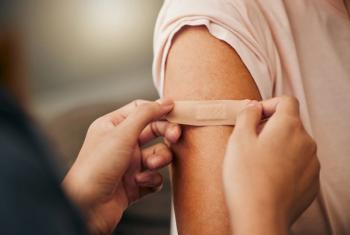
Opportunistic Vaccination: A Flu Shot For Big Sister, Too
Since mom went to the hassle of bringing along the 4 year old to her little brother's appointment, why not help make it worth the trip and get her up-to-date, too?
You have just finished an appointment with a 23-month-old boy and vaccinated him against influenza per ACIP 2014-15 recommendations. As mom is packing up to leave, you realize that the child’s 4-year-old sister is in the office as well. A few questions later you know that big sister did not get a flu vaccine last year, but had a dose in November, 2011. You agree with the idea that whenever a child is in your office you should consider administering a needed vaccine so you recommend to mom that the 4 year old get vaccinated today against the flu. Mom then asks you, should her healthy daughter get the live attenuated influenza vaccine (LAIV; FluMist) or the shot?
You tell mom that (more than one answer may be correct):
A. the ACIP does not have a preference, so either vaccine is fine.
B. the ACIP preferentially recommends the use of FluMist in
C. the ACIP preferentially recommends the use of FluMist in healthy children aged 2-8, but since you only have the inactivated shot vaccine available at this time that the ACIP recommends giving that today and not waiting for FluMist availability.
D. since dad is on immunosuppresive therapy following a lung transplant and mom works as a nurse in the newborn intensive care unit, the ACIP recommends not using the live attenuated vaccine since shedding of the vaccine virus can last weeks after a child gets the nasal spray vaccine.
Answer and discussion on
Feel free to leave a comment first.
Answer: C. The ACIP preferentially recommends the use of FluMist in healthy children aged 2-8, but since you only have the inactivated shot vaccine available at this time that the ACIP recommends giving that today and not waiting for FluMist availability.
The ACIP took an unusual step for this committee this year and has recommended the use of one specific vaccine over another. The recommendation reads: ”When immediately available, LAIV should be used for healthy children aged 2 through 8 years who have no contraindications or precautions. If LAIV is not immediately available, IIV should be used. Vaccination should not be delayed to procure LAIV.”
The ACIP based this recommendation on several studies showing significantly higher efficacy for the LAIV when compared head-to-head against IIV with no increase in adverse events including wheezing. It is true that children can shed the FluMist vaccine virus for weeks following vaccination. One study done in a day care setting did show a small (less than 2%) rate of transmission to unvaccinated children. No disease occurred.
Both the ACIP and American Academy of Pediatrics approve the use of FluMist in individuals who will have contact with immunodeficient persons, pregnant females, and preterm infants. The only exception is for individuals who will come in contact with someone in a protective, reverse isolation unit such as happens following a bone marrow transplant.
After ordering LAIV for the 4-year-old, your nurse asks you, “Does she need to come back for a booster dose in 4 weeks?” You reply:
A. No, the FluMist works so well that vaccine-naïve children only need one dose.
B. No, she had a dose in 2011 that included the pandemic strain, so she only needs one dose this year.
C. Yes, she needs a second dose since her first dose was IIV and we shouldn't switch between the live and inactivated types of vaccine when giving a second dose.
D. Yes, the ACIP recommends a second dose in this circumstance since the strains in this year's vaccine differ from the strains in the vaccine she received previously.
Answer and discussion on
Feel free to leave a comment first.
Answer: D. Yes, the ACIP recommends a second dose in this circumstance since the strains in this year's
vaccine differ from the strains in the vaccine she received previously.
Some studies have shown that a single dose of FluMist is significantly more effective than a single dose of IIV, but the ACIP still recommends two doses in vaccine-naïve persons under the age of 9 years. The vaccine in 2011 had different strains in it compared to this and last year's vaccine, so a booster is recommended. It is fine to “mix and match” the live and inactivated vaccines in getting two doses into a child in the same year.
References:
CDC. Prevention and Control of Seasonal Influenza with Vaccines: Recommendations of the Advisory Committee on Immunization Practices (ACIP) - United States, 2014–15 Influenza Season.
Newsletter
Access practical, evidence-based guidance to support better care for our youngest patients. Join our email list for the latest clinical updates.









